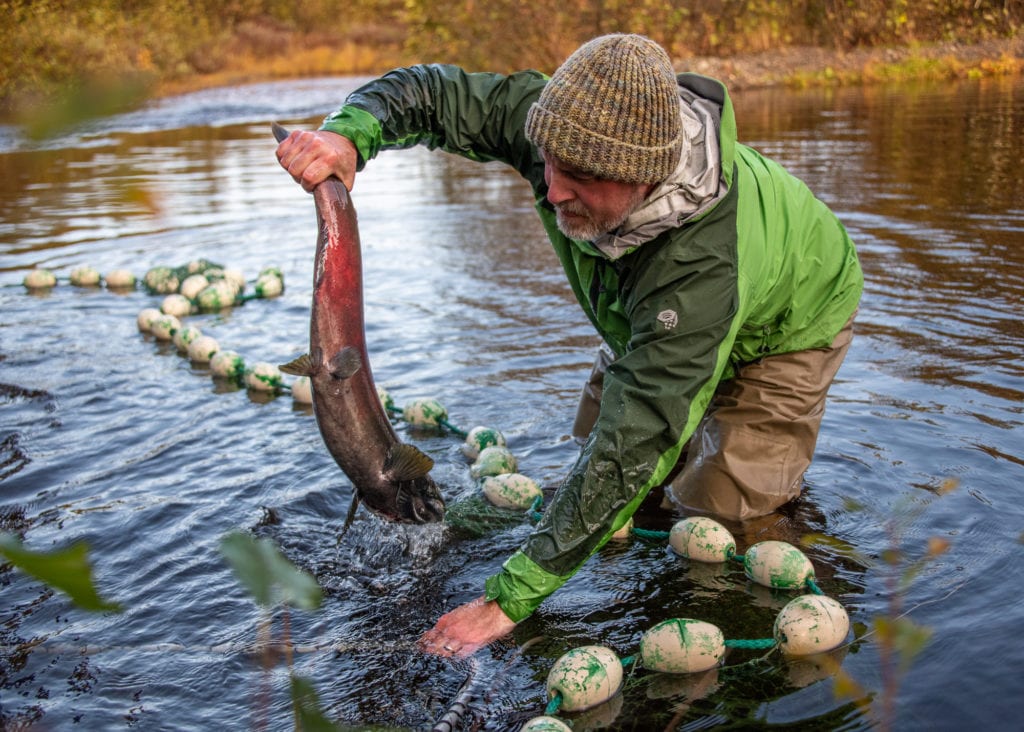
When a mischievous Mt. Eccles student cranked up the temperature on the school’s 30-gallon salmon tank, it threatened to undo months of work. But the prank also helped teach students a lesson, said Kate Morse, program director for the Copper River Watershed Project.
“It wasn’t an ideal situation, but it gave us a very teachable moment regarding climate change, and how that can affect fish,” Morse said. “It’ll help us explore some of the things that could happen in real life.”
Salmon growth is guided by how much heat the fish absorb over their lifetimes. Up to a point, more warmth causes salmon to mature more quickly. But, beyond a certain degree, the heat becomes unsurvivable. Over the past three decades, global ocean temperatures have remained consistently higher than at any other point since reliable measurements began in 1880, according to Environmental Protection Agency statistics, raising questions about how much heat salmon can tolerate
Each year, Mt. Eccles Elementary School students hatch salmon from eggs, raise them and release them. By dosing salmon with roughly the same amount of heat they’d receive in the wild, they should be roughly the same size as their contemporaries by the time they’re released, Morse said. The school’s tank has been reengineered to be more tamper-proof, although, as of 2018, there was still occasional horseplay with the temperature.
The salmon egg take for the 2019-2020 school year was held on Oct. 2. The eggs are expected to hatch around February. Throughout their maturation, the salmon will be cared for by Mt. Eccles fourth, fifth and sixth graders, who will monitor the temperature, salinity and acidity of the tank water.
“You can talk about it, but it’s different to witness it, experience it and have that hands-on connection, taking care of the salmon,” Morse said. “It’s not just a theoretical problem on a worksheet. It’s part of their lives.”
In previous years, the CRWP has obtained eggs from Prince William Sound Aquaculture Corporation. However, this year, PWSAC is using salmon stock that cannot legally be released into the wild, Morse said. As a result, Prince William Sound Science Center Board Member Tommy Sheridan and other volunteers were tasked with obtaining salmon eggs the old-fashioned way.
Sheridan, assisted by fisheries biologist Rachel Ertz and retired fisheries biologist Ken Hodges, drew a net across Holbrook Pond and began examining captured salmon for sex and maturity, searching for a mature male and female fish. Despite performing the egg take slightly out of season, a mature female salmon was quickly obtained.
Salmon reproduce by spraying seminal fluid, or milt, across eggs that have been released into the water. As fertilized salmon eggs are extremely delicate, the volunteers chose to gather the eggs and milt in separate resealable plastic bags, not combining them until after they were transported to the tank. Although mature female salmon typically carry about 2,000 eggs, the volunteers were permitted only to gather 200 eggs.
Mt. Eccles students stood by as the eggs were released from a slit cut in the female salmon’s abdomen and the milt was squeezed from the male salmon. Receiving this very frank illustration of piscine biology, some students broke into an outcry of disgust. However, Isabelle Nothstine, 10, maintained a strong stomach.
“It was really cool to watch them get the eggs and the milt for the tank,” Nothstine said. “I didn’t think it was gross.”
Isabelle Nothstine’s sister, Victoria, noticed fish laying eggs in nearby Holbrook Pond, something she’d previously only encountered in textbooks. This was a strong example of how the program helps students gain a more direct understanding of natural science, Principal Gayle Groff said.
“I’ve only read about that happening,” Victoria Nothstine said. “I never saw it before. Just seeing it is, I think, more funner than reading it.”
For 10-year-old Roman Quemado, who enjoys dining on salmon fillets, encountering entire salmon was confronting.
“You can only see the insides,” Quemado said. “When you see the whole thing, it’s like, ‘What is that?’”
As the class gathering the eggs and releasing the grown salmon fry in spring, fifth grade will focus closely on salmon throughout their classes. Over the year, the fifth graders will study not only salmon biology but the economic effects of salmon on the Cordova community.
“They learn that, if we didn’t have salmon, our community would be much smaller and less prosperous,” Groff said.





